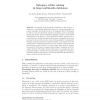Free Online Productivity Tools
i2Speak
i2Symbol
i2OCR
iTex2Img
iWeb2Print
iWeb2Shot
i2Type
iPdf2Split
iPdf2Merge
i2Bopomofo
i2Arabic
i2Style
i2Image
i2PDF
iLatex2Rtf
Sci2ools
122
Voted
DAGSTUHL
2007
2007
Subspace outlier mining in large multimedia databases
Abstract. Increasingly large multimedia databases in life sciences, ecommerce, or monitoring applications cannot be browsed manually, but require automatic knowledge discovery in databases (KDD) techniques to detect novel and interesting patterns. Clustering, aims at grouping similar objects into clusters, separating dissimilar objects. Density-based clustering has been shown to detect arbitrarily shaped clusters even in noisy data bases. In high-dimensional data bases, meaningful clusters can no longer be detected due to the curse of dimensionality. Consequently, subspace clustering searches for clusters hidden in any subset of the set of dimensions. Clustering information is very useful for applications like fraud detection where outliers, i.e. objects which differ from all clusters, are searched. We propose a density-based subspace clustering model for outlier detection. We define outliers with respect to maximal and nonredundant subspace clusters. We demonstrate the quality of ou...
DAGSTUHL 2007 | Software Engineering | Subspace Clustering | Subspace Clustering Model | Subspace Clustering Searches |
Related Content
| Added | 29 Oct 2010 |
| Updated | 29 Oct 2010 |
| Type | Conference |
| Year | 2007 |
| Where | DAGSTUHL |
| Authors | Ira Assent, Ralph Krieger, Emmanuel Müller, Thomas Seidl |
Comments (0)

